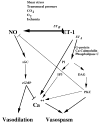Cerebral vasospasm following subarachnoid hemorrhage: time for a new world of thought
- PMID: 19298755
- PMCID: PMC2706525
- DOI: 10.1179/174313209X393564
Cerebral vasospasm following subarachnoid hemorrhage: time for a new world of thought
Abstract
Objective: Delayed cerebral vasospasm has long been recognized as an important cause of poor outcome after an otherwise successful treatment of a ruptured intracranial aneurysm, but it remains a pathophysiological enigma despite intensive research for more than half a century.
Method: Summarized in this review are highlights of research from North America, Europe and Asia reflecting recent advances in the understanding of delayed ischemic deficit.
Result: It will focus on current accepted mechanisms and on new frontiers in vasospasm research.
Conclusion: A key issue is the recognition of events other than arterial narrowing such as early brain injury and cortical spreading depression and of their contribution to overall mortality and morbidity.
Figures





References
-
- Clarke E. Apoplexy in the Hippocratic writings. Bull Hist Med. 1963;37:301. - PubMed
-
- Burnett M, Danish S, McKhann G, II, et al. Pathology and pathophysiology of aneurysmal subarachnoid hemorrhage. In: Leroux P, Winn W, Newell D, editors. Management of Cerebral Aneurysms. Philadelphia, PA: Elsevier; 2004. pp. 127–137.
-
- Weir B, Grace M, Hansen J, et al. Time course of vasospasm in man. J Neurosurg. 1978;48:173–178. - PubMed
-
- Kassell N, Torner J, Haley E., Jr The International Cooperative Study on the Timing of Aneurysm Surgery. Part 1: Overall management results. J Neurosurg. 1990;73:18–36. - PubMed
-
- Dorsch N. Therapeutic approaches to vasospasm in subarachnoid hemorrhage. Curr Opin Crit Care. 2002;8:128–133. - PubMed
Publication types
MeSH terms
Grants and funding
LinkOut - more resources
Full Text Sources
Other Literature Sources
Medical
Miscellaneous
